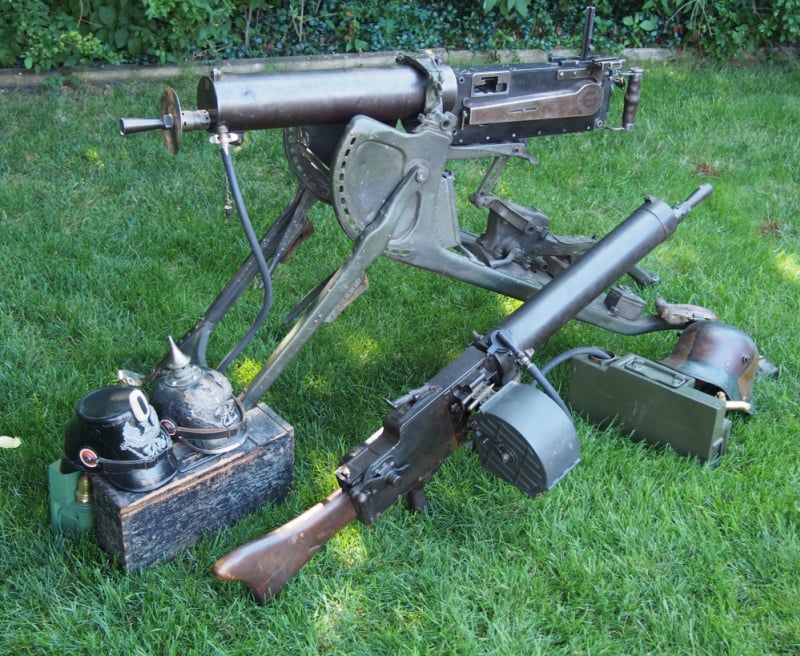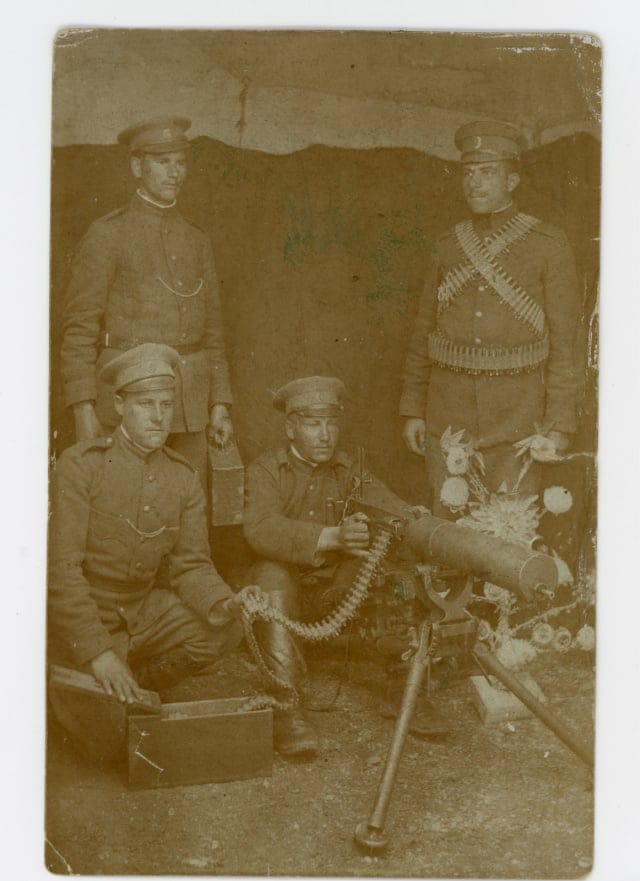Germany’s Maschinengewehr 08 was one of the most widely-used machine guns of the First World War. It contributed to the high “butcher’s bill,” and was certainly feared by any soldier unlucky enough to have to “go over the top” and cross no-man’s land. Here are some lesser-known facts about the MG08.

1. It wasn’t actually a new design.
In fact, Germany didn’t invent the machine gun, but its adaptation of Hiram S. Maxim’s original 1884 water-cooled Maxim gun arguably revolutionized modern warfare at the start of the 20th century. Germany actually licensed the design from Maxim, and that led to the development of the Maschinengewehr 08, which was produced by the newly founded Deutsche Waffen- und Munitionsfabriken (DWM).
2. Over 70,000 were made.
German Army observers had seen the effectiveness of the Maxim machine gun during the Russo-Japanese War (1904-1905), which included German exports to Russia. German Army officials sought funding to purchase additional machine guns for its units, but Socialists in the German Reichstag slowed the adoption. Yet, by the outbreak of the First World War in August 1914, the German Army had 4,411 MG08s in service—more machine guns than any other combatant nation. Production ramped up quickly, and by the end of the war, more than 72,000 MG08s were produced.

3. It was truly a “heavy” machine gun.
The MG08 was originally employed on carriages, but at the outbreak of the First World War, the machine gun was issued with a heavy “sledge” or “sled” mount—officially designated the “Schlitten 08.” Along with the nearly sixty-pound gun, the MG08 unit weighed nearly 140 pounds—not counting the water can or boxes of ammunition.
However, it was actually quite practical as a team of four could move the weapon along with its extra barrels, tools/cleaning kit, and even oil containers at the same time. The sled had a special place for the tools and even an oiler, and that ensured that nothing could be forgotten or misplaced. In addition, the sled could be folded flat so that two soldiers could carry it like a stretcher, while the other two carried the water can and ammunition boxes.


4. It had a devastating rate of fire.
The Maschinengewehr 08, which had an average rate of fire of 500 rounds per minute, was among the modern weapons that caused both sides to “dig in” during the early stages of World War I. In a fixed position the MG08 on a sled mount was devastating to any attackers.
5. A new version, the MG08/15, was designed to be portable.
The MG08 was ideal as a defensive weapon that could help repel an enemy attack, but German military planners saw a need for a more portable version. Attempts were made to create a smaller, more portable tripod but those efforts still required that troops had to stop and set up the gun to fire—a deadly proposition to undertake in no man’s land. In 1915, the Spandau factory, under the direction of Oberst (Colonel) Friedrich von Merkatz, developed a new version of the weapon.
It was the MG08/15, which was designed to be portable. It featured a pistol grip instead of the traditional “spade grips” at the back of the weapon, while a short rifle-style butt stock and a bipod were added to provide stability. Weight was still an issue, but a single soldier could carry the weapon, while a second trooper could carry extra ammunition.



6. The MG08/15 was arguably the first Squad Assault Weapon (SAW).
The MG08/15 carried a single belt of ammunition in a newly designed “belt drum” magazine that was mounted to the side. The MG08/15 proved effective as both an offensive and defensive heavy machine gun, and as a result, the German Army increased the production of the weapon.
Despite the moniker, the MG08/15 wasn’t deployed to the front lines until early 1917, and it was first used at the Second Battles of Aisne on the Western Front in April of that year.

7. It became the most common German machine gun.
By the end of the war in 1918, the MG08/15 became the most common German machine gun deployed across the front lines, and despite material shortages, the German Army even reached its goal of full allocation of six guns per company or 72 MG08/15s per regiment. In addition, there were also four times as many MG 08/15 light machine guns as heavy MG 08 machine guns in each infantry regiment.
8. Aircraft and Infantry versions were also developed.
An aircraft version of the MG08 was also developed at the Spandau arsenal. Dubbed the IMG08, it was used in pairs on the Fokker D.III and Albatros D.I. biplane. These were fitted with a synchronization gear that allowed them to fire through the propeller.
An infantry version, the MG08/18 was also developed. It was equipped with a heavy air-cooled barrel, but due to the basic design, that barrel still couldn’t be easily changed in the field.

9. Sights and Scopes
The MG08 and MG08/15 were fitted with iron sights, but a number of optical scopes were also produced. The most common was the ZF 12 scope, which was produced by Emil Busch AG at the Rathenow factory. The scopes allowed shooters to train the gun on enemy soldiers at a considerable distance.
10. The MG08/15 wasn’t entirely a dead-end on the firearms evolutionary tree.
Though it was still fitted with a water jacket to keep the barrel cooled, it was the first machine gun to be fitted with a buttstock and pistol grip. Yet, due to its shortcomings, it led to the German idiom “nullachtfünfzehn”—which translated to “zero-eight-fifteen.” Even today, it is a colloquial term used to denote something lacking in originality!
11. Widespread Service
Germany supplied the MG08 to its Central Power partners, including Austria-Hungary, Bulgaria, and the Ottoman Empire, while it had also been exported before the outbreak of the conflict. It was employed in every theater of the war and saw use with dozens of countries in the years to follow. MG08s and MG08/15s were further employed in the Russian Civil War, the Mexican Revolution, the Finish Civil War, and the Spanish Civil War. The weapons were still used in secondary roles by Nazi Germany during World War II.


12. Copies
The Chinese made copies of the MG08 based on German manuals, and introduced the weapon as the Type 24 heavy machine gun. These were primarily used by the National Revolutionary Army but captured weapons were also adopted by the People’s Liberation Army (PLA). After the PLA’s victory, a number of Type 24 machine guns were supplied to North Korea and later to the VietMinh and VietCong—and used in the subsequent First and Second Indochina Wars.
13. Chambering
The MG08 and MG08/15 were originally chambered in the standard 7.62x57mm Mauser cartridge, but export models were also produced in 7.65x53mm for military sales to Argentina and other South American countries, while a 7x57mm variant was produced for Spain.
The Chinese Type 24 was actually developed for the 7.92x57mm Mauser round, which was the standard military rifle cartridge used by National China. Weapons captured by the PLA were converted to the 7.62x54mmR, the Russian cartridge that was employed throughout the Communist Bloc during the Cold War—and which is still used by the Russian military today.

A very limited number of MG18 TuF (Tank und Flieger) models were introduced at the end of the First World War. These were chambered in the 13.2x92mm SR round, which was developed for the 13mm Mauser Tankgewehr M1918 (T-Gewehr) anti-tank rifle.
The MG18 TuF was an early attempt to be an anti-aircraft/anti-tank weapon. However, development was slow and only a few dozen were actually produced before the armistice that went into effect on November 11, 1918.



